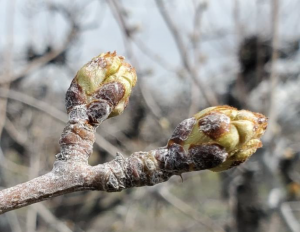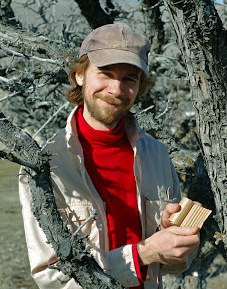Written by Louis Nottingham, Research Assistant Professor, and Robert Orpet, Postdoc Research Assistant, WSU Tree Fruit Research and Extension Center, Wenatchee, WA. Revised Jan 21, 2021.
Attention pear growers! Although it is still winter, we are approaching the time when pear psylla begin recolonizing orchards. This is a reminder to start preparing for dormant sprays of kaolin clay (i.e. Surround) to deter pear psylla colonization. A dormant Surround spray will provide the first line of defense to keep psylla from entering your orchard. The optimal time to make this first Surround application depends on weather, but here is a good rule of thumb: if it is warm and dry enough for you to safely spray, go for it – psylla are probably colonizing your orchard! Below is an article from 2020 discussing, in more detail, early season Surround sprays for controlling pear psylla.

The prebloom timeframe in pears is very important for controlling pear psylla. From February to April, winterform psylla adults move back into pear orchards from overwintering host plants (although some psylla never actually leave the orchard). Winterform adults are very active and likely move both into and among orchards. For this reason, repellent particle films such as Surround CF/WP (kaolin clay) or Celite 610 (diatomaceous earth) are essential for early season psylla control – our experiments suggest similar efficacy. Insecticides that kill adults are of limited benefit because more adults will likely invade orchards following a knockdown. Particle films not only deter winterform psylla from colonizing orchards, but also prevent those that are present from laying eggs by putting a protective coating over prime egg-laying sites. Particle films have longer lasting effects than most insecticides, especially when used at dormant and delayed dormant. Particle films are more effective and longer lasting when a spreader-sticker is added (check labels for compatibility and mixing instructions). A particle film spray at dormant or delayed dormant will reduce egg-lay on woody surfaces until soft green tissue emerges from the hard exterior bud scales (Fig. 1.). Unfortunately, continued growth of fresh new plant material from budburst to popcorn makes this a difficult window to control egg-lay with particle films. So, just prior to budburst is a good time to use an insecticide either for adult knockdown (adulticides) or fertility disruption (insect growth regulators). This will reduce egg-lay and/or viability until the buds fully open (pink/popcorn); then, another particle film spray can be used to cover the entire expanded bud. Looking forward to the summer, applying a particle film a little after petal fall will provide a first line of defense against the second generation of psylla adults (summerforms).
Reminder about Natural Enemies of Pear Psylla
The goal of all pear growers should be to suppress (not eliminate) pear psylla through the early season without causing major disruptions to natural enemies. Pear psylla outbreaks are most severe in conventional orchards in mid to late summer because natural enemies have been eliminated. A lack of natural enemies during this period, combined with resistance to insecticides and poor spray coverage once leaves are present, give psylla an opportunity for unchecked population growth. You must strike a balance, i.e. suppress the pest without disrupting natural enemies. It may seem like natural enemies are not present in the early season, but they are present and building! By relying on soft methods early, natural enemies can develop and come to our rescue once summer arrives. Particle films are not toxic to natural enemies and are very effective for suppressing pear psylla. It is essential to not only incorporate these materials into your program, but to also find ways to reduce the number of broad-spectrum sprays (for psylla and other pests). One way you can do this is tank mixing a soft insecticide with a particle film instead of using one or multiple broad-spectrum materials. We need to think both 3 months and 3 years in advance.
NOTE: Some of the pesticides discussed in this presentation were tested under an experimental use permit granted by WSDA. Application of a pesticide to a crop or site that is not on the label is a violation of pesticide law and may subject the applicator to civil penalties up to $7,500. In addition, such an application may also result in illegal residues that could subject the crop to seizure or embargo action by WSDA and/or the U.S. Food and Drug Administration. It is your responsibility to check the label before using the product to ensure lawful use and obtain all necessary permits in advance.
Contacts
 Louis Nottingham
Louis Nottingham
Research Assistant Professor
WSU TFREC Wenatchee
email: louis.nottingham@wsu.edu
phone: 509-293-8756
 Robert Orpet
Robert Orpet
Postdoc Research Assistant
WSU TFREC Wenatchee
email: robert.orpet@wsu.edu
phone: 509-293-8756
Use pesticides with care. Apply them only to plants, animals, or sites listed on the labels. When mixing and applying pesticides, follow all label precautions to protect yourself and others around you. It is a violation of the law to disregard label directions. If pesticides are spilled on skin or clothing, remove clothing and wash skin thoroughly. Store pesticides in their original containers and keep them out of the reach of children, pets, and livestock.
YOU ARE REQUIRED BY LAW TO FOLLOW THE LABEL. It is a legal document. Always read the label before using any pesticide. You, the grower, are responsible for safe pesticide use. Trade (brand) names are provided for your reference only. No discrimination is intended, and other pesticides with the same active ingredient may be suitable. No endorsement is implied.
Treefruit.wsu.edu articles may only be republished with prior author permission © Washington State University. Republished articles with permission must include: “Originally published by Washington State Tree Fruit Extension Fruit Matters at treefruit.wsu.edu” along with author(s) name, and a link to the original article.
